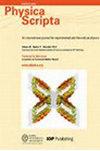Hysteresis gap-shrinking and structural effects of minor Al and Ti modifications on binary CuAl-based high-temperature shape memory alloys
IF 2.6
3区 物理与天体物理
Q2 PHYSICS, MULTIDISCIPLINARY
引用次数: 0
Abstract
Cu-based shape memory alloys (SMAs), except for exhibiting shape recovery, superelasticity, and high damping, are desirable because these smart materials have higher electrical and thermal conductivity and much lower prices than NiTi SMAs. However, they also have some downsides in mechanical strength and brittleness (mostly stemming from their coarse grain structure) and thermal instability. Therefore, adding some grain refining elements to these SMAs to improve their shape memory effect (SME), and thermal, structural, and mechanical properties is a widespread and simple way that significantly affects their martensitic phase transitions, structure, and mechanical properties. One of these grain-refining elements is titanium. Its thermal conductivity is lower than those of Cu and Al elements and has a low solubility in Cu-matrix. Besides the effects of small Al variations, the use of minor amounts of titanium in binary CuAl-base alloys can show impressive effects on all characteristics of these shape memory alloys, such as shape memory effect properties, martensitic transformation kinetics parameters, and microstructural features. In this research work, CuAlTi ternary high-temperature shape memory alloys (HTSMAs) with new compositions were produced by the arc melting method without a complicating use of Mn or Ni components in usual ternary CuAlMn and CuAlNi shape memory alloys. Thermal analyses of the prepared samples of the alloys were investigated by using differential scanning calorimetry (DSC) and differential thermal analysis (DTA) measurements. In contrast, x-ray diffraction (XRD) test results and optical micrographs were used for analyzing the structure of the alloy samples. The effect of different amounts of low soluble and grain refining Ti element on the binary CuAl alloy system was investigated.对二元 CuAl 基高温形状记忆合金进行少量 Al 和 Ti 改性的磁滞间隙收缩和结构效应
铜基形状记忆合金(SMA)除了具有形状恢复、超弹性和高阻尼之外,还具有更高的导电性和导热性,而且价格比镍钛 SMA 低得多。不过,它们也有一些缺点,如机械强度和脆性(主要源于其粗晶粒结构)以及热不稳定性。因此,在这些 SMA 中添加一些晶粒细化元素以改善其形状记忆效应(SME)以及热、结构和机械性能,是一种广泛而简单的方法,可显著影响其马氏体相变、结构和机械性能。钛就是这些晶粒细化元素之一。钛的热导率低于铜和铝元素,在铜基体中的溶解度也较低。除了少量铝元素变化的影响外,在二元 CuAl 基合金中使用少量钛元素也会对这些形状记忆合金的所有特性,如形状记忆效应性能、马氏体转变动力学参数和微观结构特征产生令人印象深刻的影响。在这项研究工作中,采用电弧熔炼法制备了具有新成分的 CuAlTi 三元高温形状记忆合金(HTSMA),而没有使用通常的 CuAlMn 和 CuAlNi 三元形状记忆合金中复杂的 Mn 或 Ni 成分。利用差示扫描量热法(DSC)和差示热分析法(DTA)对制备的合金样品进行了热分析。而 X 射线衍射(XRD)测试结果和光学显微照片则用于分析合金样品的结构。研究了不同数量的低溶解性和晶粒细化 Ti 元素对二元 CuAl 合金体系的影响。
本文章由计算机程序翻译,如有差异,请以英文原文为准。
求助全文
约1分钟内获得全文
求助全文
来源期刊

Physica Scripta
物理-物理:综合
CiteScore
3.70
自引率
3.40%
发文量
782
审稿时长
4.5 months
期刊介绍:
Physica Scripta is an international journal for original research in any branch of experimental and theoretical physics. Articles will be considered in any of the following topics, and interdisciplinary topics involving physics are also welcomed:
-Atomic, molecular and optical physics-
Plasma physics-
Condensed matter physics-
Mathematical physics-
Astrophysics-
High energy physics-
Nuclear physics-
Nonlinear physics.
The journal aims to increase the visibility and accessibility of research to the wider physical sciences community. Articles on topics of broad interest are encouraged and submissions in more specialist fields should endeavour to include reference to the wider context of their research in the introduction.
 求助内容:
求助内容: 应助结果提醒方式:
应助结果提醒方式:


